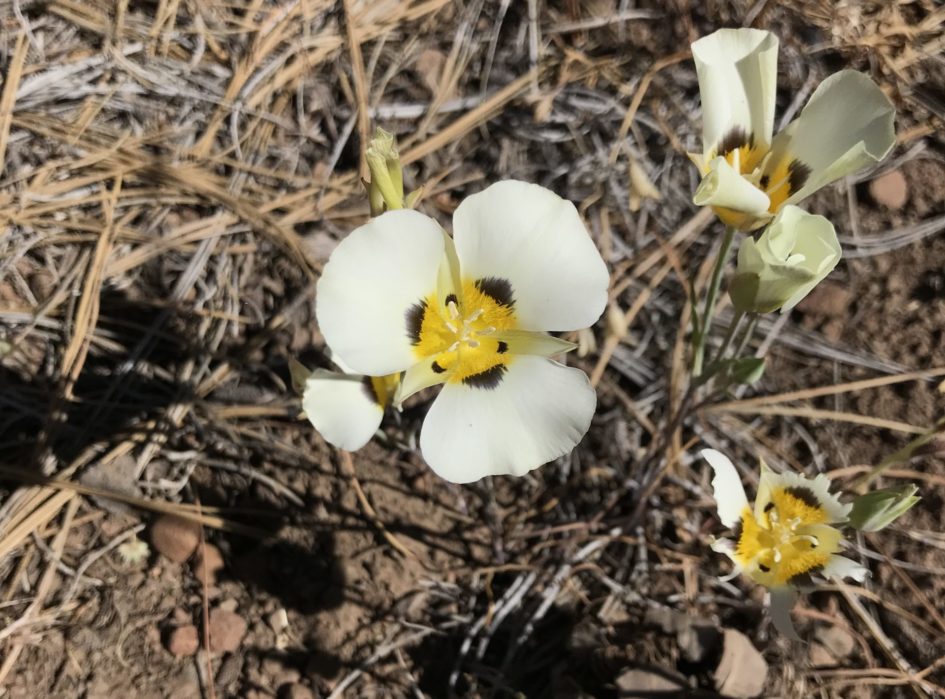Now that recent rains have completely reconfigured California’s hydrological world—and it’s a record year for California’s snowpack—I wanted to return briefly to the wildflower theme of our last post. Partly because, thanks to the rainfall, we may have a great season for wildflower blooms throughout the state (take a look at this useful guide to places and prospects) and partly because I wanted to offer one more literary take on Golden State wildflowers, Ina Coolbrith’s “The Mariposa Lily,” a poem from California’s first poet laureate.
For a time, Coolbrith was a leading figure among California literati. The niece of Joseph Smith, ten-year old Coolbrith emigrated to California with her family in the company of the scout, James P. Beckwourth. After a failed marriage, she wound up in San Francisco working on The Overland Monthly with Bret Harte and Charles Warren Stoddard. Eventually she became the first librarian for the Oakland Free Library, where, according to scholar Cheryl Walker, “Her job required her to spend 11 hours a day, six days a week, at the library. Such poems as she was able to write under those conditions were ‘songs’ she made up and carried in her head until she had leisure to write them down” (29). Her circle came to include Isadora Duncan, Jack London, and Joaquin Miller, who borrowed his first name from the legendary bandit Joaquin Murieta at Coolbrith’s suggestion. Eventually she became California’s first poet laureate. Though her poems are unfamiliar to most of us now, as Walker points out, “Coolbrith has never entirely disappeared from view” (30). Maybe that’s because her “songs” can be pretty good, like “The Mariposa Lily”:
Insect or blossom? Fragile, fairy thing,
Poised upon slender tip, and quivering
To flight! a flower of the fields of air;
A jeweled moth; a butterfly, with rare
And tender tints upon his downy wing,
A moment resting in our happy sight;
A flower held captive by a thread so slight
Its petal-wings of broidered gossamer
Are, light as the wind, with every wind astir,—
Wafting sweet odor, faint and exquisite.
O dainty nursling of the field and sky,
What fairer thing looks up to heaven's blue
And drinks the noontide sun, the dawning's dew?
Thou winged bloom! thou blossom-butterfly!
I have no idea which of the 45 varieties of mariposa lilies growing in California Coolbrith depicts here. (The one pictured up-top is the smoky mariposa, Calochortus leichtlinii, growing in the foothills near Truckee). Maybe she had no one particular species in mind. The butterfly conceit that derives from the name of the flower conjures an insect, sure, but in the poem, the wings are of indistinct color, “tender tints,” we’re told. What kind of butterfly embodies that description? No way to tell because she refuses to specify color, leaving many possibilities for readers to imagine, perhaps drawing on their own encounters—real or from art?—with the delicate and apparently weightless creatures. I imagine nothing like the pale yellow and black stripes of a tiger swallowtail, nor the dark copper, black-veined monarch. Maybe the pale hue of the non-native cabbage white will serve?
Whatever image evoked, the poem shifts from the ostensible focus on a blossom to the natural surroundings wherein the plant grows, thereby introducing qualities of atmosphere, “fields of air,” “light as the wind,” “heaven’s blue,” and “noontide sun.” Impressive bit of sleight-of-hand, conjuring a flower by name only to zoom out to gather into view the whole of our sensate world.
I suspect that in the coming months Californians will be able to find all kinds of mariposa lilies. They’re not as iconic as the state flower, the California poppy (Coolbrith has written about Eschscholzia californica, too) but mariposa lilies are tough, belying their apparent delicacy.
And they grow all over the place. Take a look.
Sources
Feature photo by the author.
Beers, Terry. “Writing Central Valley Wildflowers.” Rewriting California. https://rewritingcalifornia.com/writing-central-valley-wildflowers. Accessed 10 March 2023.
Calflora Data Base. “Mariposa Lily.” https://www.calflora.org/entry/psearch.html?namesoup=mariposa+lily&countylist=any&plantcomm=any&format=photos&orderby=taxon. Accessed 14 March 2023.
Coolbrith, Ina. “Copa De Oro.” Songs from the Golden Gate. Houghton Mifflin, 1895. https://www.google.com/search?tbm=bks&q=coolbrith+songs+from+the+golden+gate. p. 152. Accessed 9 March 2023
—. “The Mariposa Lily.” Songs from the Golden Gate. Houghton Mifflin, 1895. https://www.google.com/search?tbm=bks&q=coolbrith+songs+from+the+golden+gate. p. 30. Accessed 9 March 2023.
Hopewell, Deb and Bailey Berg. “Where to See California’s Wildflowers This Spring.” AFAR Magazine. 14 February 2023. https://www.afar.com/magazine/california-wildflowers-where-and-when-to-find-them. Accessed 9 March 2023.
“Mariposa Lily.” Los Padres ForestWatch. 2013. https://lpfw.org/our-region/wildlife/mariposa-lily. Accessed 10 March, 2023.
Walker, Cheryl. “Ina Coolbrith and the Nightingale Tradition.” Western Women Writers, Vol. 6, No. 1, 1989, pp. 27-83. https://www.jstor.org/stable/25679048. Accessed 10 March, 2023
Want to be notified when new posts are added? Subscribe to our newsletter.

